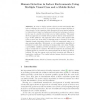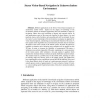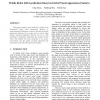20 search results - page 3 / 4 » Color Landmark Based Self-Localization for Indoor Mobile Rob... |
ICRA
2005
IEEE
13 years 11 months ago
2005
IEEE
— This paper presents a visual attention mechanism for the acquisition of landmarks in an arbitrary scene. The proposed mechanism consists of two consecutive selection stages. Th...
JIRS
2006
13 years 5 months ago
2006
Abstract. Autonomous mobile robot navigation systems are based on three principal kinds of techniques: map-based navigation, map-building-based navigation and mapless navigation. W...
CIARP
2007
Springer
13 years 11 months ago
2007
Springer
In order to deploy mobile robots in social environments like indoor buildings, they need to be provided with perceptual abilities to detect people. In the computer vision literatur...
ECCV
1998
Springer
13 years 9 months ago
1998
Springer
Different applications in the field of vision-based navigation of autonomous mobile robots depend on the degree of knowledge of the environment. Indoor environment applications oft...
ICRA
2003
IEEE
13 years 10 months ago
2003
IEEE
This paper presents a novel method for mobile robot localization using visual appearance features. A multidimensional-histogram is used to describe the global appearance features ...



